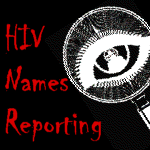 |


|
|
Compiled by GayToday
 Washington, D.C.--The Centers for Disease Control and Prevention (CDC) has released
for public comment new guidelines that call on states to track HIV cases as
an extension of their AIDS case surveillance programs.
Washington, D.C.--The Centers for Disease Control and Prevention (CDC) has released
for public comment new guidelines that call on states to track HIV cases as
an extension of their AIDS case surveillance programs.
The CDC's statement says: "From 1995 to 1996, the incidence of both deaths and opportunistic infections (OIs) due to AIDS declined in the United States for the first time in the history of the epidemic (6 percent for OIs; 23 percent for deaths) as reported in the September 19, 1997, Morbidity and Mortality Weekly Report (MMWR) (Volume 46, pp. 861-867). "These declines reflect recent advances in treatment of HIV infection and the provision of care and services that have slowed the progression of AIDS for HIV-infected persons on therapy and the success of HIV prevention and education efforts that have encouraged early diagnosis and have helped to reduce the number of Americans becoming infected with HIV. "In response to these changes in HIV treatment practices and new information needs of public health programs, CDC, the Council of State and Territorial Epidemiologists (CSTE), and most other public health and AIDS organizations have recommended that all States and Territories conduct HIV case surveillance in addition to AIDS surveillance. "In this manner, the AIDS/HIV epidemic can be tracked more accurately, and appropriate information about HIV/AIDS can be made available to policymakers. As of July 1998, a total of 32 States were conducting HIV case surveillance using the same methods as surveillance for AIDS. Because some States (many with large numbers of AIDS cases) do not report HIV case numbers, interpretations of available HIV data are difficult. "To gain more reliable information about the prevalence, incidence, and future directions of HIV infection and the impact on specific populations such as racial and ethnic minorities and women, CDC is proposing that the current surveillance system be expanded to include HIV case reporting for all States and is publishing guidelines that States can use to implement HIV surveillance. The Human Rights Campaign says that while advising that a names-based reporting system will most efficiently achieve the data quality standards established by the guidance, the CDC document explicitly states that it will provide technical assistance and financial support if states choose another option like a system based on unique identifiers.
 "The CDC has moved in the right direction on the issue of HIV surveillance,
but they still might push states too hard to collect names, according to
Human Rights Campaign spokespersons.
"The CDC has moved in the right direction on the issue of HIV surveillance,
but they still might push states too hard to collect names, according to
Human Rights Campaign spokespersons.
"Last year, CDC officials said that they would not support states with funding and technical assistance if they chose a non-names based reporting system. I am pleased that the CDC has decided to be more flexible and we will monitor closely their pledge to support alternative HIV surveillance systems," said Seth Kilbourn, HRC's senior health policy advocate. A system of reporting HIV to state health departments with a person's name has been controversial because many public health officials and HIV advocates believe that such a system will drive people away from counseling, testing, and health care systems. HRC supports HIV surveillance using a system of unique identifiers in which a person with HIV would be reported to public health officials by some form of a unique code that could not be traced back to the person. Currently, in all 50 states, anyone who develops full blown AIDS is reported by name to state health department. The state makes sure that each case is reported only once and then sends demographic and other information to the CDC, without the person's name. Twenty two states currently have a similar system for people who test positive for HIV. Many health professionals have said that current AIDS based surveillance system has become less useful in recent years because the success of new treatments has resulted in people living with HIV for longer periods of time without developing full blown AIDS. A surveillance system based solely on AIDS cases is therefore no longer a good measurement of the epidemic in the United States. "We have always acknowledged that we need to have a national system in place to track HIV rather than just AIDS. The controversy has always been on how to achieve this result," said Kilbourn. In addition to recommending strict security and confidentiality of data, the guidelines also establish that states should have anonymous testing sites available, unless precluded by state law. In a recent study published in the Journal of the American Medical Association, the authors found that people who tested anonymously tended to get into care systems earlier than people who got tested confidentially. The study concluded that anonymous testing contributes to early HIV testing and medical care. "We expect that the CDC will actively push states to re-establish or maintain their anonymous test sites," said Kilbourn. "We also expect that the Clinton Administration will actively oppose efforts in Congress which undermine anonymous testing, confidentiality of data, or state flexibility in establishing an HIV reporting system." The most recent CDC study shows 240,000 people living with AIDS in the United States. The agency estimates that as many as 660,000 other people are infected with HIV, but that only 500,000 of them know it. Related Stories from the GayToday Archive: AIDS: How World Religions Respond World AIDS Day Alert: How to Save Lives! Related Sites: CDC Guidelines Draft Text Comments GayToday does not endorse related sites. |
